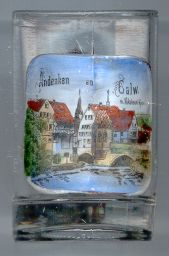

|
| DEUTSCHLAND | GERMANY |
| Bundesland: Baden-Württemberg | |
| Regierungsbezirk: Karlsruhe | |
| Landkreis: Calw |
Calw is situated at an elevation of 390 m on the river Nagold in the Black Forest region.
The name was first mentioned in document of 1075 and is derived from the old German word chalo (bare place).
The town it self seems to have been founded prior to 1256 by the counts of Calw. The family had founded the
monastery of Hirsau (today part of Calw) in AD 830, and again in 1049. After the family had become extinct, the town and the castle
were sold to the house of Württemberg in 1308 and 1345, respectively. In the 16th century, Calw became a centre for
 textile trading. During the Thirty Years' War, the protestant town was completely destroyed by the Imperial troops in 1634.
Although Calw was rebuilt after that, it was destroyed again during the Palatinate War of Succession in 1692. The following
centuries were marked by a decline of Calw's role as a trading town, but new roads and the opening of railway lines in 1864 and 1872
initiated the transformation of the town to an administrative and cultural centre of the region.
textile trading. During the Thirty Years' War, the protestant town was completely destroyed by the Imperial troops in 1634.
Although Calw was rebuilt after that, it was destroyed again during the Palatinate War of Succession in 1692. The following
centuries were marked by a decline of Calw's role as a trading town, but new roads and the opening of railway lines in 1864 and 1872
initiated the transformation of the town to an administrative and cultural centre of the region.
The Gothic  Nikolauskapelle [centre] next to the bridge across the Nagold river was built around 1400.
The chapel was renovated in 1926 and is a landmark of Calw.
Nikolauskapelle [centre] next to the bridge across the Nagold river was built around 1400.
The chapel was renovated in 1926 and is a landmark of Calw.
Most famous son of Calw is the German poet and novelist Hermann HESSE (1877–1962). His breakthrough novel was
„Demian“, published in 1919. His most widely read books are „Siddharta“ (1922),
„Steppenwolf“ (1927), „Narziss und Goldmind“ (1930), and „Das Glasperlenspiel“ (1943).
Hesse received the Nobel Prize for Literature in 1946.
![[scale]](lineal.jpg)